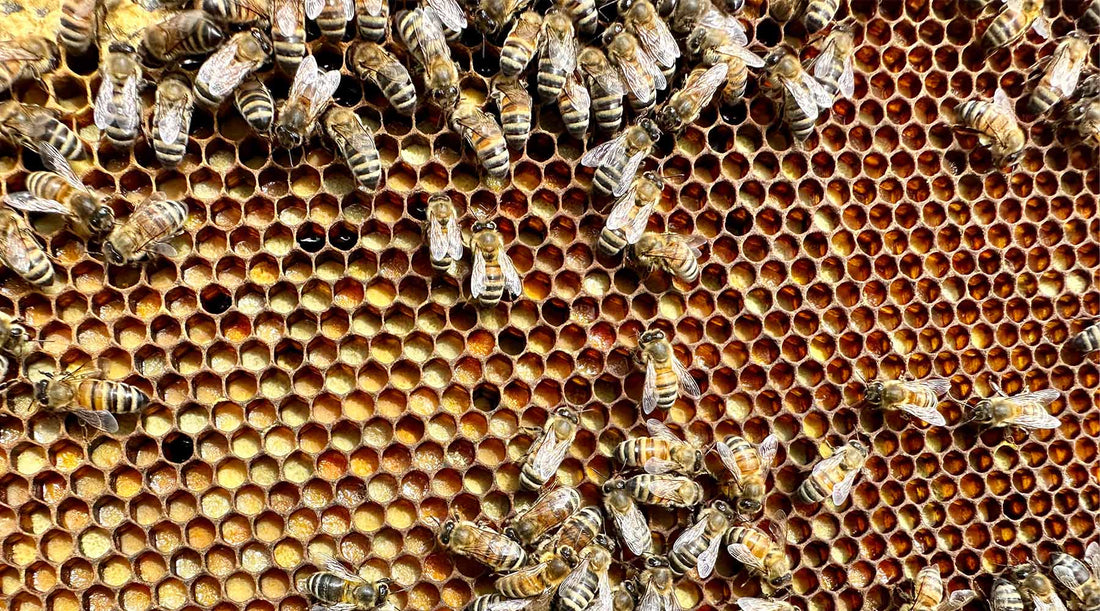World Bee Day only comes once a year. But given their importance, it’s worth celebrating or at least thinking about bees more frequently. Not only do bees enrich their local environments, but without them, the food system as we know it would collapse.
Bees also have surprisingly complex social systems and incredibly specialized roles within their communities. But despite their formidable work ethic, bees and other pollinators face increasingly difficult conditions. So this May 20th, remember to celebrate bees and consider the actions you can take to help these little miracle workers thrive.
The many hats of the worker bee
Bees have surprisingly complex social systems. You likely know about the three categories of bees within the colony — the queen, her busy worker bees, and the infamously idle drones. But within these groupings, the members of the community take on much more specialized roles.
The queen bee’s role is to lay eggs and replenish the ranks of her colony. Drones have a similar role — they’re sexually mature males whose unique purpose is to mate with the queens in neighbouring colonies.
That leaves the worker bees to undertake all the rest of the work of sustaining the colony. Foraging and honey production are their most well-known tasks. But workers are responsible for everything else, from helping each member of the colony begin their life cycle to shepherding them through the end of it.
Every bee in a colony begins its life being nursed by a worker. These so-called nurse bees are responsible for nourishing the newest members of the brood with royal jelly, a milky, nutritionally jam-packed goop secreted from specialized glands in their heads. But only the youngest bees, between five to 15 days-old, can make it.
So what do these nurse bees do for the first days of their lives before they begin producing royal jelly? They clean. A worker bee starts her life by chewing off the wax capping of her cell and cleaning it out. This allows the honeycomb cell to be repurposed for honey storage, or as an incubator for the queen to lay another egg in.
After her days as a nurse bee have finished, a worker can take on a number of different roles. She may be deputized as a member of the queen’s entourage, responsible for feeding and grooming her. Alternatively, she may be tasked with making the bee bread — a mixture of pollen, nectar, honey, and bee saliva — to feed the young nurse workers as well as any larvae older than three days.
Somewhere between the first 12 and 18 days of her life, the young worker bee will likely produce a different kind of glandular substance. In this case, it’s beeswax, which comes from four pairs of glands on her abdomen developed exclusively for this task. In this role, she’ll be responsible for repairing damaged parts of the comb or adding new cells.
Only after this point can a worker begin her position as a forager, seeking out pollen and nectar for the colony. Alternatively, she may be tasked with overseeing the colony’s security. For this role she’ll check each bee as they enter the hive, ensuring that they’re a true member of the group instead of an intruder intent on stealing honey. In this capacity, she’s also on the lookout for predators including raccoons, skunks, and wasps.
In her later days, a worker bee may also take on the role of an undertaker. Bee colonies can have anywhere from 10,000 to 80,000 members, depending on the season. And during the summer, a typical colony can lose upwards of a thousand bees a day. That leaves the potential for a lot of dead bodies inside the hive.
In order to keep their home clean and disease-free, undertaker bees wait until their dead relatives dry out a little (so they weigh less) before carrying them out and depositing them in the surrounding area. Their tiny bodies eventually decompose, returning nutrients to the soil and contributing to the ecosystem even in death.
A worker bee may appear to be long-lived due to the variety of roles she takes on, yet the opposite is actually true. While a queen bee lives an average of one to two years, worker bees max out at 200 days — and that’s in the fall and winter when they’re in a semi-hibernation state. During the frenetic activity of summer, the life expectancy of a worker bee hovers between 15 and 38 days.

How bees impact their environment
Worker bees may be short-lived, but their impact on the environment is outsized. In their quest for honey, bees seek out pollen and nectar, and pollinate numerous plants as a result.
Almost every variety of fruit requires pollination, as do many nuts and seeds like almonds, sunflower seeds, and cashews. Others, such as sesame, are wind pollinated, but see an additional benefit from pollination by bees and other insects.
Many of your favourite vegetables also depend on bees and other pollinators — beans, brussel sprouts, cauliflower, cucumber, and zucchini are just a few.
Fruits and veggies aren’t the only pollinator-dependent heavy hitters — cocoa trees also require tiny visitors to reproduce. And, while cotton and some varieties of coffee plants are self-pollinating, bees and other pollinators can substantially increase their yields.
Bees provide advantages that extend beyond domesticated crops. They’re also necessary for the survival of several wild animal species who depend on food sources like wild blueberries and clover.
Moreover, the thousands of bees that die each year provide valuable nutrients for the soil as their bodies decompose just outside of their hives.
How modern agriculture threatens bees
Bees may be the cornerstone of our agricultural system, but modern farming practices actively harm these industrious creatures. Widespread pesticide use is the norm for the majority of large-scale agricultural producers, and the products they use can have devastating consequences for the bees.
Neonicotinoids, or neonics, are the most widely used insecticide worldwide. They’re applied to crops like wheat, corn, canola, and soy to protect them from pests. Unfortunately, their effects aren’t confined to just the pests. Neonics are also highly toxic to beneficial insects like bees and butterflies.
Herbicides are another category of pesticide with concerning consequences. You’ve likely heard of a number of alarming reports regarding glyphosate (a.k.a RoundUp). But despite its detrimental effects on humans, animals, and pollinators, it continues to be the most-used herbicide in Canada.
While greenhouse and organic farming have taken off in Canada, industrial agriculture still accounts for the majority of farmland in the country. And unfortunately, their practices aren’t confined to their geographical boundaries.
Water systems, soil, and wind pick up and spread these pesticides, affecting much larger areas than where they’re intentionally sprayed. Moreover, because bees don’t know when they’re crossing the boundary from a “safe” area into a pesticide-laden one, there’s nothing to stop them from coming into direct contact with plants that have been treated with pesticides, herbicides, or both.
Pesticide use isn’t the only stress bees encounter as a result of industrial agriculture. The practice of using bees to pollinate monocultures like almonds is especially devastating. Travelling beekeepers from all over the US wake their hives months early to service the almond blossoms of Southern California in their push to produce a bumper crop.
This results in a record number of honeybee hives in close proximity to one another, making it easy for pests and diseases to tear through the population. That, coupled with intense pesticide use in the vicinity, makes almonds an especially hazardous crop for the bees.
And outside of agriculture, urban sprawl has depleted the natural areas and wide varieties of vegetation that bees need. In many cases, this has resulted in large swaths of land devoid of anything for bees to eat.
How can you help the bees?
The situation facing the bees may sound dire, but bees are nothing if not resourceful — especially with a little help from you. While it may not seem like there’s a lot one person can do, your immediate actions can impact your environment more than you may think.
Here are five bee-friendly practices you can undertake to support our fuzzy, yellow friends:
1. Buy organic or greenhouse-grown produce whenever possible.
Due to its protected environment, greenhouse-grown produce doesn’t require the pesticides or herbicides traditionally used by large-scale agricultural producers. This makes it both bee-friendly and a healthier option for you and your family.
2. Purchase honey from small-scale, local producers.
Honey isn’t immune to factory farming-type practices, which can involve inhumane treatment of honeybees. In some cases, large-scale producers will cull colonies they assess as weak in order to avoid feeding them over the winter.
Another common practice is to harvest all of the honey the bees produce, leaving them with a synthetic syrup to over-winter with instead. Since honey contains a number of nutrients that have beneficial health impacts, this practice can leave the bees weak and more prone to disease. The next time you’re shopping for honey, consider a local producer to help ensure you’re supporting a business that treats its bees humanely.
3. Consider switching from almond milk to a different plant-based alternative such as oat milk.
Oats are self-pollinating. And, because they’re a bumper crop in Canada, your oat milk likely doesn’t have to travel as far to get to you, thereby lowering your carbon footprint. Choosing it over almond milk for your morning cereal or morning cuppa, means you’re not supporting monoculture practices like almond farming.
4. Avoid using pesticides or herbicides in your garden.
There are many ways to deal with weeds and pests without turning to chemicals. A simple spritz with soap and water can help eliminate some invasive, pesky pests, but companion planting is also a great bet. This means planting things that are attractive to insects that eat common garden pests.

5. Plant a wildflower garden.
You might not think a few flowers will accomplish much, but if you live in an urban area, your little patch of colour can provide crucial sustenance to nearby bees. Not just any flowers will do though. Planting native species ensures you’re contributing to the natural balance as well as choosing the specimens local bees are most likely to love.

